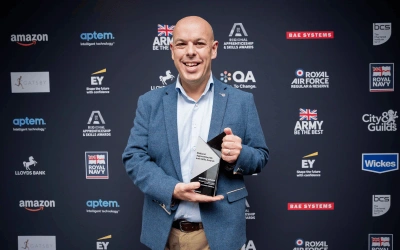Last week Lorien held our event ‘How to win the candidate: speed, security and standing out’, hosted by myself and moderated by Recruiting Brainfood’s Hung Lee, with guest speakers Neil Denton, Director of Recruitment for the UK from Capgemini, Kally Kang-Kersey, HR Influencer, Richard Matthews, Head of Talent and Resourcing at The Co-operative Bank, and Christine Ng, Talent Acquisition Partner at The Financial Times. Together, we looked at talent attraction in a competitive post-pandemic landscape – where talent attrition is high and candidate attraction means standing out from the crowd. Here are my key takeaways.
1. Candidates today have more choice
After eighteen months of uncertainty and hiring freezes, the recruitment market has bounced back – more companies are hiring to catch-up to plan or to meet new strategies, and more candidates are receptive to moving. With fewer candidates than opportunities, this candidate-driven market is resulting in intense competition (with counteroffers becoming the norm), salary inflation, and more negotiation around flexible working. The popularity of remote working also means that the competitor pool for talent is much wider. Candidates can be poached from any location, by any company. With so much demand, some candidates are using the current market to benchmark rates and negotiate better offers at existing employers.
2. Job security is influencing the market
Market uncertainty early on in the pandemic influenced candidate behaviour, with candidates sticking out roles in unaffected sectors and jumping ship in troubled sectors. Christine noted the influx of applications The Financial Times received for normally skill scarce senior engineers in 2020 – attributing this to the need for security. But where candidates in 2020 were fighting for safe passage through the COVID-19 storm, in 2021 there are plenty of opportunities to explore. Richard and Hung discussed the idea that some candidates might have used unaffected sectors as ‘shelters’ during the pandemic, and how new opportunities might tempt those same candidates away again.
3. Opening up new talent pipelines is key for candidate attraction
All of our panellists have invested in new ways of sourcing talent to overcome the supply and demand gap. For Neil, it was about improving the early talent pipeline; for Christine, it was about early engagement and talent pipelining over longer periods; and for Kally, it was about refreshing alumni channels for referrals and returners, and enhancing I&D strategies to attract talent from all backgrounds.
4. Candidate expectations have changed
Where remote working and flexible working used to be on a wish list, now it has become an expectation. Neil explained how this can be difficult to navigate as a client-led business, where going onsite was sometimes required. Our panellists also noticed a shift in pace for flexible working requirements, with requests for reduced hours, condensed hours or working from home brought up in interview. Candidates today also want to know what their future holds and want the opportunity to try lots of different things – a by-product of the pandemic where many people were forced to skill shift. According to Kally, candidates today want to flex their opportunities and try different things rather than being pigeonholed.
5. EVP means both looking after, and being looked after
Richard explained how the pandemic caused a shift in interest for meaningful, ethical work. People are now looking for roles where they can contribute to society, and it’s important to create a job design where people feel like they are making a positive impact. On the other side of the coin, people are also looking at the individual ethics of employers and how they treated their staff during the pandemic. Christine added that this was also linked to career development and internal mobility, with employees having more faith in companies that were supporting their career development even during difficult times.
6. Harness technology and follow the data to streamline processes
Kally stressed the importance of being sharper with decisions to speed up processes. She cited hiring manager training and investing in technology to improve decision making processes (e.g. AI for CV sifting) as examples of how to do this. This was echoed by Neil who said educating hiring managers on market conditions using MI and delivering training was important for a slick process. Data was also important for scrutinising processes at each stage to locate bottlenecks and breakdowns. Many of our panellists said that they would likely adopt a hybrid approach to interviewing in the future, providing the flexibility for either virtual or in-person interviews and assessments.
7. Keep your processes short, sweet, and high touch
The candidate journey should be short, but high touch. Many of our panellists had moved away from technical testing to reduce timeframes but also to access different skillsets that might otherwise have been ruled out. Where hiring managers once wanted a full tick list for candidates, the talent short market meant that assessing potential was more important where skills gaps could easily be bridged. Our panellists advocated a two-stage interview process and said setting candidates’ expectations on the process early on was important for retention. Richard recommended clear, regular communication for candidate retention, with regular touchpoints throughout the journey and into onboarding strongly recommended to retain candidates over their notice period.
8. Final takeaways
Lastly, we asked our panellists for some final words of wisdom about attracting candidates in today’s market. Neil stressed the importance of agility and personalisation to pick up the best candidates, as well as the importance of educating hiring managers on the state of the market. Christine emphasised the need for teamwork and clear, aligned communication between different departments to ensure nothing drops off. For Richard, hiring manager engagement and briefing was the most critical thing, ensuring hiring managers understood not only market conditions but also saw the data and experienced the pain of dropouts to improve efficiency. Kally believed that talent attraction today means being open to different types of people, and not equating brand prestige or years of experience with success – you need to assess talent in a way that makes sense for your business.
A huge thank you to our panellists for their insight and to Hung Lee for moderating the event – plenty of takeaways for anyone hoping to improve their candidate attraction and retention this year! If you would like to watch the full recording of the event, or discuss any takeaways, please reach out to me at Darren.topping@lorienglobal.com.







